Life was good: the rains fell, wildlife, nuts, and fruits were abundant, and the Naconichi Caddo people were content. The good rains insured success with the crops: it had been several generations since the people began to regularly plant corn, beans, and squash, but they always felt blessed when the crops were successful. Feasts and ceremonies accompanied the gathering of another year’s crops. All the people felt proud of their accomplishments when the crop was safely stored away in each family’s storage pit.
The people chose areas to establish settlements along Naconiche Creek where there were well-drained sandy soils that were easy to dig, and stood on landforms that were not prone to flooding, as well as places near stands of hickory and acorn and brushy areas where deer and other game animals could be readily found and fish and mussels could be gathered. Nearby suitable local clays were also a factor in setting up a household because each family had to make their own cooking and serving vessels (decorated with their own particular stylistic elements and imagery), and ready sources of good workable clay were prized by potters. Clay also came in handy when building screens around cooking fires and hearths.
Although the people were neighborly, the Naconichi Caddo were rural folks, and they liked their space and the open lands around their household compounds. If they could see the smoke from their neighbor’s houses, that was close enough.
The Naconichi were busy harvesting the corn crops from their fields, and this was a good year—there would be more than enough maize to last the people over the course of the next year, keeping aside some of the best seed stock. While the women and some of the more responsible children worked to shell the maize cobs for storage, other children gathered water or chased the dogs; other women set out newly-made pots to dry in the sun.
The men talked about the tools they would need for the upcoming hunt in the next valley—they had heard the deer were abundant there—and they wondered where they could find better sources of stone than what was available in creek gravel beds. The men had heard of a particular family a few miles downstream that had access to better cherts and were producing tools for distribution to neighboring families. They wondered what they wanted in exchange for a good quiver of stone-tipped arrows. Mostly, though, the men lounged against the walls of the houses, just talking and waiting for the corn hominy to be heated and ready to eat. There was always time to talk.
Later, the Naconichi were to meet with their neighbors to dance and sing, remember and commune with their ancestors, and renew their social relationships. It was likely a feast was in the offing, along with games, and a good smoke. They would give thanks to God for their good lives, the health of their families, and the good will of the caddi and conna. The Naconichi Caddo were thriving, and they knew their prosperity would continue.
13th-15th Century Caddo Occupations
By the 13th century A.D., Caddo lifeways along Naconiche Creek were in full bloom. The Caddo lived in sedentary communities organized primarily as small households and farmsteads spread across the land, situated near arable soils. Maize was an important part of the diet, but not as much as what has been documented in other contemporaneous Caddo populations.
These Caddo formed a tight-knit community of kin-related families. They shared stored foods as well as pottery vessels and stone tools made by craft persons living within the community, and obtained other necessities from Caddo groups that lived both north and west of them. These Caddo, ancestors of the poorly known Naconichi Caddo, enjoyed life and their many blessings—even in the bad times—and were flourishing. They had relationships with their neighbors, especially those at the important Caddo mound center at the Washington Square Mound site, about a day’s walk away.
The archeological evidence of household activities is much more robust for the later Caddo occupations at Lake Naconiche, due in part to a more intensive occupation of the general region and project area, as well as better preservation of features and plant and animal remains. In each instance, the Caddo occupations are small residential households, likely occupied by no more than 1-2 households at any one time, that are part of a dispersed community in the Naconiche Creek valley.
Households are social and economic units that occupied individual or multiple residential structures as part of a social and economic unit. In an archeological sense, a community refers to a group of households that shared a regular social interaction at a specific set of places within a particular span of time.
Farming and Wild Plant Collecting
Prehistoric Caddo groups at Lake Naconiche cultivated maize (Zea mays), beans (Phaseolus vulgaris), and squash (Cucurbita sp.), tropical cultigens introduced into the eastern United States no earlier than about 2000 years ago for maize. Archeological evidence from Caddo sites suggests that these remains were nowhere common until after ca. A.D. 800, and in the case of beans, they were not commonly grown until after ca. A.D. 1250.
Maize was recovered in flotation samples at the Tallow Grove, Foggy Fork, and Beech Ridge sites in 13th to 15th century A.D. contexts. Squash rinds were also recovered from Foggy Fork. Charred beans were present in 13th to 15th century A.D. contexts at Tallow Grove as well as the probable Late Caddo Stroddard site (41NA243) along Telesco Creek.
We do not know precisely how or where these prehistoric Caddo laid out their fields. Historic accounts of Hasinai Caddo settlements dating to the 17th and 18th centuries suggest that fields were probably nearby, covering no more than an acre per household. The fields were cleared with wooden and stone tools to remove brush, weeds, and grasses, as well as dead trees or overhanging limbs. Seeds were planted (in two plantings?), and the fields then carefully tended to protect the crop from small animals and deer. It is likely that the fields of the Naconichi Caddo were in the immediate proximity of residential structures. For example, in the case of the Beech Ridge site fields may have occupied the open area with little habitation debris between the north and south occupational areas. Some crops may also have been planted in areas where the sediments were enriched by trash middens. Living nearby would permit close observations of the fields.
By far the most important wild plant food collected by the Naconiche Caddo was the hickory nut. Harvesting the forest mast and rendering vegetable oil was a principal food collecting and processing activity at each site. The vegetable fat and protein rendered from the nuts provided an excellent complement to white-tailed deer, which is very low fat, as well as to high-carbohydrate wild roots and fruits, and the domesticated crops produced in gardens.
Other wild plant foods that were collected by the Caddo included acorn and black walnut, as well as honey locust and wild grapes. Undoubtedly, various greens, seeds, tubers, and roots were also collected when they were available.
Woods used for structures and fuel primarily consisted of oak, along with other hardwoods (including willow, American beech, American hornbeam, ash, birch, box elder, chinkapin, dogwood, elm, hackberry, honey locust, Hop hornbeam, and persimmon) and pine. Black walnut may have been gathered for use as wooden hoes, as could hickory wood. Fragments of charred giant cane were recovered from each of the Caddo sites, and they may represent discarded structural material from prehistoric houses. Cane was apparently used for the floors of raised storage platforms, and on beds and other secondary furnishings. Corn may have been stored on giant cane platforms raised above house doors.
Hunting and Trapping
The recovered animal remains from the prehistoric Caddo sites point to an increasing diversification in hunting and trapping strategies after ca. A.D. 1250. This is apparent in the lower percentages of deer and large mammal remains in the Caddo sites, as well as the higher numbers of small and medium-sized mammals, turtles, rabbits, and birds. Small and medium-sized mammal remains account for 29-41% of the faunal remains in the Tallow Grove and Beech Ridge components, compared to only 11-16% at the Woodland period sites and the Formative Caddo occupation at the Boyette site.
The Late Caddo fauna at the Naconiche Creek site are primarily from deer and large mammals. Animal species diversity remains relatively high in Late Caddo times, as medium and small-sized mammal bones are also abundant, along with rabbit and beaver as well as birds. Turtle was also common, being almost twice as frequent compared to the Woodland period faunas.
Use of Dogs
The Caddo peoples living along Naconiche Creek had domesticated dogs. They would have been important as hunting partners, watchdogs, and as garbage disposers; dogs may have been responsible for the consumption as well as destruction of meaty butchering waste discarded in trash deposits. There is no evidence that dogs were eaten by these Caddo. Dog bones were found at the Tallow Grove, Naconiche Creek, and Boyette sites; one of the dogs recovered at Tallow Grove had been placed in a small pit in a midden deposit upon its death.
In historic times, Spanish missionaries commented on the dogs they observed in Caddo villages in East Texas. Fray de Solis noted that the Caddo: “have…some dogs also which they call jubines because they are a mixture of dog and coyote or wolf. These dogs are very intelligent and cunning as well as great thieves; they have thin pointed snouts.”
House Construction
There is abundant evidence for structures at the Lake Naconiche Caddo sites, but house patterns are not always easy to read. Because most organic materials were poorly preserved and the sandy soils were subject to bioturbation (disturbance by tree roots and burrowing animals) structural outlines were rarely clearly defined by posthole patterns. Adding to the challenge is the fact that Naconiche Caddo structures were rebuilt or otherwise modified. Nevertheless, the number of postholes found in restricted areas, the presence of hearths and other types of pit features, the distribution of anthropogenic deposits, and the range of domestic artifacts, leave little doubt that there were domestic structures (houses) associated with each of the Caddo occupations.
The structures were built primarily with oak posts or poles well set in the ground (especially the center post and any main support posts), and were likely covered with interlaced branches and grass thatch. The virtual absence of daub suggests that the Caddo structures did not have a clay covering over the thatch.The houses were likely circular in shape, although the outline shape was not always clearly defined.
At the Tallow Grove and Beech Ridge sites, there was good evidence for several domestic structures built from the 13th century to at least the mid-15th century. Evidence included: central hearths with a post underneath, wall support post arcs, large and small basin-shaped pit features enclosed within the arcs, and patches of organically-stained sediments that appear to mark the accumulation of debris on the floor of structures. There were at least three houses at Beech Ridge and four at Tallow Grove. They appear to have been circular in shape, and between ca. 6-10 m in size. Two of the structures at Tallow Grove have central hearths with postholes underneath them.
The three domestic Caddo structures at the Beech Ridge site are in two spatially discrete household compounds with an open courtyard or common area between them. The structure in the southern principal occupational area was apparently rebuilt on two occasions. One of the northern structures has a central hearth (with a large central posthole underneath it).
A 15th century house (Structure 1) at the Foggy Fork site was a bit more than 8 m in diameter, with an entrance to the east, and a small midden deposit behind it to the south. Within the structure was one large basin-shaped pit feature and a basin hearth. Several small postholes within the structure may represent parts of internal screens or divider around the large basin-shaped storage pit.
At the Naconiche Creek site, postholes formed a roughly oval shape, covering a ca. 4 x 4.7 m area; a large basin-shaped pit occurs within this area. Several of the postholes are larger than typical wall support posts, and thus it is probable that these posts are part of an outdoor work platform or ramada.
Based upon historic accounts, it is likely that between 6-20 Caddo people—one family or several extended families—lived in each of the farmsteads at any one time. The Foggy Fork structure described above may have been large enough for 8-10 people to live.The evidence tells us that more people resided at the Tallow Grove and Beech Ridge sites, with perhaps as many as 20 people living there during any single occupation.
Storage
Large pits found at each of the prehistoric Caddo sites were likely used for storage. The large pit volumes of between 7-17 bushels are well within the range of annual plant food storage needs for Caddo horticultural families.
The mean volume of the large pits suggests that between 200-400 kg of maize could be stored in them. This would have been enough maize to feed a family of three to six people for an entire year if 30% of their diet came from maize consumption, which seems consistent with the paleobotanical and stable carbon isotope data from the sites.
The Foggy Fork and Naconiche Creek sites have one or two large storage pits, implying relatively short occupations by Caddo families, because storage pits deteriorated as the result of use, opening and reopening, and the effects of rain. When a pit became unusable, it was usually filled with domestic trash, and a new pit was excavated Since no new pits were observed, these sites were apparently abandoned before new storage pits were needed. At the Beech Ridge site, the southern occupational area had three large storage pits, probably not all in use at the same time, but apparently representing a serial sequence of storage pit use and abandonment.
At the Tallow Grove site, there are 18 such large pits with a combined volume of 152 bushels. This amount of storage capacity is out of all proportion to the needs of what appears to have been a prehistoric occupation with no more than four families, since 152 bushels of plant food stuffs would be sufficient for 12 families or 60 people. This suggests that the inhabitants at the Tallow Grove site may have been storing maize not only for their use but for the use of other Caddo families living along Naconiche Creek.
Above-ground granaries have been identified in some post-A.D. 1350 Caddo sites in East Texas. Such elevated granaries are also mentioned in historical documents, but no evidence of elevated granaries was detected at the Lake Naconiche Caddo sites.
Cooking
After ca. A.D. 800-1000 domesticated plant foods and meats were probably prepared with a cooking technology where foods were cooked and boiled in ceramic vessels that set directly over or nestled in a fire. Ceramic jar sherds have charred residues and sooting on them, evidence that they came from vessels placed directly in a fire during cooking.
An important meal that surely would have been prepared in the cooking vessels, at least after ca. A.D. 1250, was hominy. This was a gruel prepared with crushed corn kernels mixed with wood ash, meat, and/or beans. To make hominy, corn kernels were pounded with wood ashes in or on a mortar (wood or stone), sifted through a basket to winnow away chaff and corn hulls, mixed in a cooking jar with water and other ingredients for flavoring, and then boiled for several hours to make a gruel or stew. Europeans noted that the Hasinai Caddo made hominy in the late 17th century by parching the corn and then pounding it very fine with a long wood pestle in wood mortars made from a tree hollowed out by fire.
The occurrence of fire-cracked rock (FCR) at Caddo sites, in particular at the Boyette and Tallow Grove sites, also suggests that some plant and animal foods were cooked using the older hot rock technology. Certain foods probably were baked in small earth ovens or cooking pits into which hot rocks had been added to as part of the baking process. The rocks would have functioned as heating elements and helped maintain even and prolonged baking.
Pottery Making
Pottery is the quintessential artifact found at prehistoric and historic Caddo sites (see Created in Clay). Pottery and pottery sherds are ubiquitous, and occur in considerable numbers, representing many hundreds of vessels used and broken during the course of a 1-2 generation occupation. The Caddo made ceramics in a wide variety of vessel shapes, and with an abundance of well-crafted and executed body and rim designs and surface treatments.
Ceramics at Typical Residences
Each Caddo household would have had an impressive diversity of vessel forms among both the fine wares and utility wares. These wares were designed to serve different purposes—from a cooking pot to the mortuary function of a ceremonial beaker—and this is reflected in differences in paste, surface treatment, firing methods, decoration, and vessel form. Ceramic vessels were used in the cooking and serving of foods and beverages, in the storage of foodstuffs, as personal possessions, and as beautiful works of art and craftsmanship (i.e., some vessels were clearly made to never be used in domestic contexts). Pottery vessels also functioned as social identifiers: certain shared and distinctive stylistic motifs and decorative patterns marked closely related communities and groups.
Among the Naconiche Caddo sites, three temporally and stylistically distinct ceramic assemblages were recognized, dating from pre-A.D. 1100 times to well after ca. A.D. 1300. Within each of these ceramic sets are groups of distinctive household ceramic assemblages comprised of varying proportions of decorated fine wares and utility wares.
From 72% to more than 95% of the vessel sherds from the 13th-15th century A.D. Caddo households were from utility ware vessels, and these were clearly the principal vessels in use at Naconichi Caddo residences. Utility wares are decorated cooking and storage vessels made for everyday use. Fine ware engraved vessels were most abundant in pre-A.D. 1100 contexts, with utility ware cooking and storage vessels decorated with brushing, incised lines, punctations, etc., becoming increasingly important in household assemblages after ca. A.D. 1250. These vessels have principally simple straight line geometric elements and motifs.
Thirteenth century A.D. and later ceramic sets are dominated by brushed utility ware jars, and smaller proportions of fine wares. Less then 2% of the vessel sherds at the 16th century and later Naconiche Creek site were from fine ware vessels.
The 13th-15th century engraved wares—among them bottles with curvilinear elements —include geometric designs, as well as hatched pendant triangles, diagonal or vertical hatched panels on Poynor Engraved vessels, cross-hatched engraved zones or panels, and negative ovals. These share general stylistic affiliations with contemporaneous pottery assemblages of Caddo groups living in the Neches, Angelina, and Attoyac stream basins, including sites such as Washington Square, Tyson, several sites at Lake Sam Rayburn, and the Deshazo site.
Clay Sources
Several different local clay sources were used by the Caddo potters that lived along Naconiche Creek, based on the results of instrumental neutron activation analysis (INAA). The specific clay sources and outcrops that were used have not been identified within the project area. The Caddo preferred Smith and Titus chemical group clays, which are slightly different in chemical composition from each other, but probably available locally.
Colors and Pigments
Red hematite-rich pigments and white kaolin clay pigments were used as a colorful embellishment to some of the fine wares. These pigments were carefully rubbed into the engraved designs of certain kinds of vessels, most particularly bottles and occasionally a carinated bowl. The red pigment was the preferred pigment for this form of surface decoration. A hematite-rich clay slip was occasionally used as a decorative technique on a few fine ware vessels.
Vessel Forming and Vessel Forms
Caddo vessels were made by coiling strips of tempered clay together to form the vessel body and rim, and then the body was joined to a separately shaped disk base. The coils were smoothed with a round river pebble to create the finished vessel form; some unused coils exposed to fire have been preserved. Vessels were constructed from the bottom up, with thinner walls moving up the vessel body towards the rim, and with the lower portion of the vessel—especially the base—usually significantly thicker than the upper portions of the vessel.
Fine ware vessels include carinated bowls, deep compound bowls, simple bowls, and bottles. The fine wares have a finely tempered paste, are usually burnished or well-smoothed on one or both vessel surfaces, and were carefully decorated with engraved designs, engraved designs with pigments, or were covered with a red slip. The Caddo utility vessels have a coarse paste, a rougher surface treatment, and thicker body walls than the fine wares, probably related to the performance needs of the cooking pot to withstand thermal shock and cracking during use. Typical utility vessel shapes included small to large jars, as well as a variety of conical and simple bowl and plain bottle forms. The utility vessels have carbon encrustations, food residues, and soot stains from use as cooking pots. Some of these kinds of vessels were used primarily for storage (those with large orifice diameters and vessel volumes) of foodstuffs and liquids.
Firing
There are significant differences in how utility ware and fine ware vessels were fired. Fine wares were better made and better fired, and they were probably fired longer in a low oxygen environment than the utility wares. The Caddo potters exerted more control over the end product of fine ware vessel manufacture than they did with the utility wares, primarily to produce a harder ceramic. Firing conditions tended to be more varied among the utility wares, likely the product of the multi-purpose nature of these vessel forms. As long as their porosity was not excessive, and there was a good balance between clay plasticity and temper constituents, utility wares did not need to be fired for as long as the harder fine wares to be serviceable.
There are clear differences in vessel firing practices between the earlier Caddo occupations at the Boyette site and the later post-A.D. 1300 Caddo occupations. Reduced fired vessels were the most common in the earlier Caddo ceramics. There is also evidence of unintentional smothering, smudging, or sooting, as well as vessel sherds from possible reheated/multiple fired vessels. The Woodland sandy paste sherds from the Boyette and Naconiche Creek sites share these firing condition characteristics, namely evidence of poorly controlled vessel firings.
Later Caddo ceramic vessels tend to be more commonly fired in an oxidizing environment or were more likely to be incompletely oxidized during firing. This difference in firing conditions may be a consequence of the increasing manufacture and use of utility ware coarsely-tempered jars after ca. A.D. 1250 that did not need to be well fired to high temperatures to be serviceable and durable utility ware vessels.
Exchanging Pottery with Other Regions
On the basis of the INAA measurements of decorated sherds from prehistoric Caddo contexts, less than 10% of the pottery on the Lake Naconiche sites had been obtained in exchange with other Caddo regions in Northeast Texas. The few examples are from pre-A.D. 1100 and post A.D. 1400 contexts.
In other words, the vast majority of the pottery was locally made. Procurement and Working of Lithic Raw Materials
Like earlier peoples in the Lake Naconiche area, prehistoric Caddo groups relied on local gravels for the manufacture of chipped stone tools, and also procured raw materials for grinding stones from stream and bedrock outcroppings of sandstone, hematite, and ferruginous sandstone. Local gravels included a variety of different colors of cherts, along with petrified wood and quartzites.
Finished or nearly completed chipped stone and groundstone tools were sometimes made from non-local materials from sources along the Red River in Northeast Texas or even farther afield in the Ouachita Mountains of southeastern Oklahoma and Central Texas. These materials were never common at any one time during the post-A.D. 1300 Caddo occupations, accounting for less than 7% of the arrow points. Flake tools in these prehistoric Caddo sites were commonly made on non-local lithic raw materials, however, and it seems evident that the Caddo peoples had better access to non-local sources of raw material than did Woodland groups. Given the long distances to source areas, it is unlikely that these non-local lithics were directly acquired by the Naconiche Caddo. They probably obtained these materials (either in the form of finished tools or tool blanks) through trade and exchange relationships with both Caddo groups living to the north and non-Caddo groups living to the west.
The technology in use by Caddo knappers was flake-based, meaning that the ultimate goal in the working of lithic raw materials was to obtain usable flakes for arrow points and other flake tools, both expedient and more formally shaped tools. Flake tools were more often found on non-local raw materials because these high-quality materials were sharper and had a better cutting edge than the local chert, quartzite, or petrified wood raw materials.
Household Variation in the Use of Raw Materials
Each of the Caddo households relied upon local pebble cherts, petrified wood, and quartzite materials, but in differing proportions, probably influenced greatly by local differences in gravel bed abundance. The relative scarcity of non-local lithic raw materials in the arrow points—indicating a roughly comparable access to such materials—seems to suggest that the prehistoric Caddo peoples had to primarily rely on local raw materials for the manufacture of these tools. Non-local materials were exhaustively used whenever they could be obtained.
The ca. A.D. 1200-1300 arrow point series at the Tallow Grove and Beech Ridge sites were made more commonly from petrified wood than either local chert or quartzite. By the 14th and 15th centuries, petrified wood was the raw material of choice—likely because it is relatively abundant locally. At the 15th century Foggy Fork site, almost half of the arrow points were made from petrified wood.
Local cherts are well represented in the formal flake tools, as is petrified wood. The highest proportion of petrified wood formal flake tools is from the Beech Ridge site. Local pebble cherts are particularly well represented in the expedient flake tools at the Tallow Grove site, while petrified wood expedient flake tools are more common at the Beech Ridge site. Thirty percent of the expedient flake tools from the Naconiche Creek site are made from a local quartzite; this material is very rarely used for tools at the other prehistoric Caddo sites.
Another real difference between Caddo households is the disparity in the emphasis on chipped stone tool production. The Tallow Grove and Beech Ridge sites are essentially contemporaneous Caddo habitation sites separated from each other by less than 100 m, but the density of lithic debris between the two sites is striking. In the main habitation area at Tallow Grove, the density of lithic debris is 177 pieces per cubic meter, but the density per cubic meter of tool knapping debris is only 27.7 pieces at the Beech Ridge site. The density of lithic debris is even lower at the Foggy Fork site: 12.9 pieces per cubic meter.
The limited amounts of lithic debris at the Foggy Fork and Beech Ridge sites indicates little emphasis on chipped stone tool production from beginning to end at these 14th and 15th century A.D. Caddo sites. Conversely intensive chipped stone tool production (i.e., an estimated 3460 arrow points were discarded, based on 1.28 points per square meter of excavated deposits) took place at the same time at Tallow Grove. It is probable that some of the households at Tallow Grove were manufacturing stone tools for use by other Naconiche Creek households.
Use of Stone Tools Chipped stone tools from the prehistoric Caddo occupations in the Naconiche Creek valley are dominated by arrow points, outnumbering flake tools almost 3:1. Hunting was important to the Caddo peoples living at these sites. Based on the sheer numbers of arrow points at the sites, hunting was more frequently carried out at Naconiche Creek, Boyette, and Tallow Grove than at the Foggy Fork and Beech Ridge sites.
Looked at another way—the ratio of arrow points to ground stone tools, a measurement of the relative importance of hunting versus plant processing in these Caddo sites—it does appear that hunting activities were also important at Foggy Fork, at least relative to the amount of plant food processing. At the other Caddo sites, the ratio of arrow points to ground stone tools is similar, suggesting that hunting and plant food processing activities were both important. The diminished numbers of ground stone tools at Foggy Fork may reflect the increased use of wooden mortars and pestles for maize processing, perhaps to make hominy.
In addition to arrow points and arrow point preforms (indicating the on-site manufacture of such tools), flake tools are an important part of the prehistoric Caddo chipped stone tool kit. This primarily includes expedient flake tools, as well as scrapers, drills, and perforators, which were used for cutting, scraping, and perforating tasks on a variety of materials.
Ground stone tools such as abraders and pestles from the prehistoric Caddo components would have been used for wood and bone shaft and tool straightening in the case of the abraders, for pounding food stuffs in the case of pestles, while hammerstones were employed in chipped and ground stone tool manufacture.
Pulverizing Plant Foods
Ground stone tool assemblages from the Lake Naconiche sites are relatively consistent from site to site. Ground stone tools are more diverse in form and presumed function(s) than those found in Woodland occupations. The most common ground stone tools are manos, mano-pitted stones, relatively thin grinding slabs, and pitted stones. Other ground stone tools include large mortars and abraders.
These ground stone implements were primarily used for processing hickory nuts, acorns, seeds, and other plant foods, including corn. These plant foods would have been gathered from nearby woods and fields, then brought back to the settlements for processing. The mortars, metates, and grinding slabs would have been used to pound or grind nut meats, as well as seeds and corn kernels, but the latter were also probably finely ground in a wooden mortar with a wooden pestle to make a corn gruel or hominy. The stone manos found in considerable numbers might also have been employed to grind and pound the hickory nuts into finer pieces in a stone or wood mortar, thus prepared, the hickory nut pieces were then heated and cooked in ceramic jars to make hickory nut oil and nut oil soup.
Tree Felling and Woodworking
Celts found on Caddo sites are the best candidate for tree felling and woodworking tools. These distinctive chipped, pecked, and polished hafted tools are usually made on non-local metamorphic rocks from sources along the Red River or the Ouachita Mountains, but have also been made from local petrified wood . They are found only in Caddo archeological deposits at the Lake Naconiche sites, being particularly common at Foggy Fork and Beech Ridge in 14th and 15th century A.D. contexts. Celts may have been used for tree felling, tree-girdling, and woodworking activities, as well as in field preparations and house construction activities.
Craft ActivitiesCertain craft activities other than pottery manufacture and stone tool knapping were undoubtedly important activities around Caddo households. These crafts relied on perishable materials—wood, bone, shell, leather, wool, skins, and feathers—with which the Caddo, primarily the women, made seats and benches, baskets, boxes, and mats, textiles, rope, spoons, cups, and ornaments, wood platters and effigies, mortars and pestles, hoes of wood and bone, rattles, flutes, rattle sticks, and feather garments and fans. None of these materials or craft goods were preserved at any of the Lake Naconiche sites, and in general they are very rarely ever encountered in Caddo archeological contexts. A few recovered artifacts, however, provide indirect evidence that such craft activities took place in prehistoric times among the Caddo people living along Naconiche Creek.
Bone Tools for Basket Making, Hide Scraping, Punches, and Percussors
Bone tools are not abundant, being found only at Tallow Grove, Naconiche Creek, and Beech Ridge. One deer metatarsal from the Beech Ridge site was employed apparently for hide scraping, but the tool could also have been used for basket making or even corn shelling. Several antler fragments and a worked antler tip from the Caddo components were probably used as punches, percussors, or pressure flakers in the manufacture of chipped stone tools.
There is an awl fragment recovered from the Naconiche Creek site. This bone awl would have been used in basket making to split and trim the stitching splints of grass or cane, as well as to punch a hole between the stitches to draw through another stitching splint to attach another basket coil.
Pipe Making
In East Texas Caddo sites, pipes were made with clay. The pipes would have been used to smoke tobacco (wild or domesticated) or other leafy plant materials, and pipes were imbued with ritual, prayer, and sacredness.
At Lake Naconiche, clay pipes were made in several different styles and forms, including long-stemmed Red River style pipes, elbow pipes of two different forms (L-shaped and rounded bowl), and a very distinctive platform pipe style from Tallow Grove. Clay pipes, however, are not common at any of the Caddo sites, possibly because the social rituals associated with pipe smoking may have taken place in larger social gatherings and ritual performances at the residences of the social and political elite. Only the rounded elbow pipe form (from Foggy Fork) was decorated, and the one example had a single engraved line encircling the bowl rim.
The earliest Caddo pipes on Naconichi Caddo sites are the long-stemmed forms, with small and delicate bowls. These were still in use at the time—probably in the 14th century A.D.—when the Caddo began to make L-shaped elbow pipes and platform pipes with larger bowls that could hold more smoking materials. Finally, the rounded elbow pipe form, again with a large bowl several times larger than the long-stemmed pipe bowl, began to be popular in the 15th century A.D. and continued to be made into historic times by the Caddo.
Sherd Disks and Textile WeavingSpindle whorls on two of the Caddo sites suggests that Caddo women were processing fibers to produce textiles from the 13th to the 15th centuries A.D. Materials that could have been used include animal hair and various vegetable fibers, among them hemp, slippery elm, mulberry, milkweed, and nettle, as well as the bark of trees.
Pigments and the Crushing and Grinding of Hematite
Pigments/ochre pieces are present in small amounts in the ground stone tool assemblages at the Caddo sites. The recovery of these pigment sources hints at some use of hematite and limonite as ready sources of pigment for personal body decorations and for application on ceramic vessels.
Ritual and Mortuary Practices
The Caddo Indian peoples have strong and long-standing religious ceremonies and rituals associated with burials and mortuary practices. In the case of the Caddo burials from Lake Naconiche, the deceased individuals (primarily adult men and women, although child and juvenile burials of unknown sex were also documented) were buried in an extended, supine position. These burial places were intended by the Caddo to have been their final and permanent resting places.
The extended burials were typically placed in pits oriented northwest-southeast or north-south, with the deceased’s head facing to the northwest towards the summer solstice, or to the north; their arms rested at their sides. One of the burials at Tallow Grove was placed in a pit that was oriented east-west, but as there were no preserved skeletal remains, it is not known in which direction the body was facing. Preserved funerary offerings included pottery vessels placed near the shoulders or head in four of the 12 burials, with only one to two vessels per individual, and stone tools (drills) placed by the left arm of an adult of unknown sex (Feature 66) at the Tallow Grove site. Two of the Tallow Grove adult burials had charcoal concentrations on or near the floor of the burial pits. These likely represent the remains of small fires used to burn food placed in the graves prior to the time of their final interment.
The cemetery at Tallow Grove was situated behind, but near, the area of the three northern structures and structural deposits, on the crest of the alluvial landform. The number of burials in the cemetery—eight—is not indicative of a lengthy or intensive Caddo occupation. A population of 20 adults and children living at the site for 40 years, and having a moderate annual death rate, could reasonably have these many deaths. It is likely that the Caddo families that lived in the three structures north of Midden 1 at Tallow Grove buried their dead in this cemetery. This close association between the spatial placement of the dead in the Tallow Grove cemetery and the location of several households affirms the likelihood that the family or kin group that lived there maintained an active association with the dead.
Only four burials, two from each site, were identified at Beech Ridge and Boyette. These date from the 13th to the early 15th century A.D. In the case of the Beech Ridge interments, these were placed outside of habitation features, but not far from residential/domestic occupational deposits. Conversely, at the Boyette sites, the two burials there were placed amidst extensive habitation debris; in fact, the child burial was placed near the top of a large storage or earth oven pit that was not in active use. Here too, the occupants of these households surely maintained a close relationship to the deceased buried amidst them. |
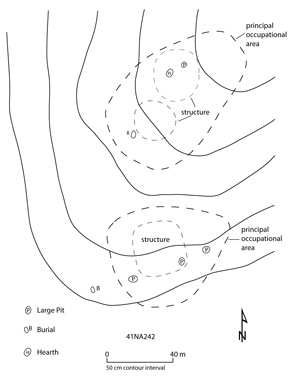
The Middle Caddo period occupation at Beech Ridge.  |
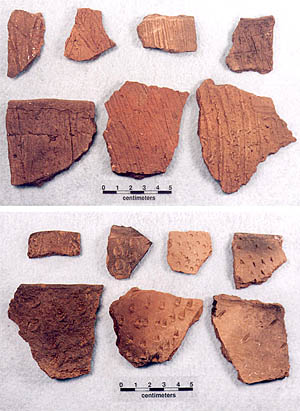
Above and Below: Cooking and storage vessels decorated with brushing, incised lines, and punctations became increasingly important in Caddo household assemblages after ca. A.D. 1250.  |
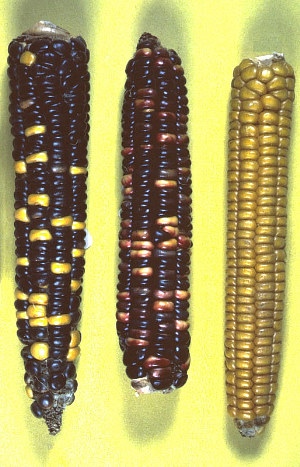 Heirloom varieties of "Indian corn" thought to be similar to the maize grown by Caddo ancestors. The ear to the left is 7.5 inches long (19 centimeters). At Lake Naconiche, maize was recovered in flotation samples at the Tallow Grove, Foggy Fork, and Beech Ridge sites in 13th to 15th century A.D. contexts. Photograph from Richard I. Ford, courtesy Dee Ann Story.  |
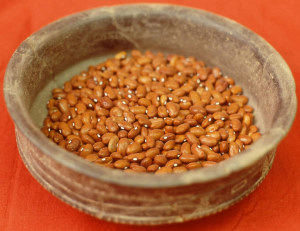 Dried beans in an ancient Caddo bowl. The Caddo grew five or six varieties of beans according to Fray Casaņas, a Spanish priest who lived among the Hasinai Caddo in 1691. At Lake Naconiche charred beans were present in 13th to 15th century A.D. contexts at Tallow Grove. Photo by Frank Schambach.  |
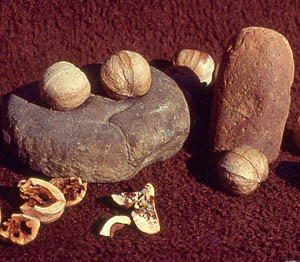 By far the most important wild plant food collected by the Naconiche Caddo was the hickory nut. Harvesting the forest mast and rendering vegetable oil was a principal food collecting and processing activity at each site. Photograph by Frank Schambach.  |
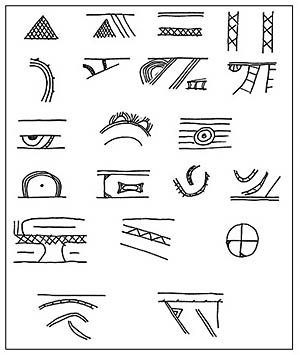
Geometric designs are common on the engraved pottery fragments found at the Tallow Grove, Beech Ridge, and Foggy Fork sites. Enlarge to see images of some of the sherds.  |
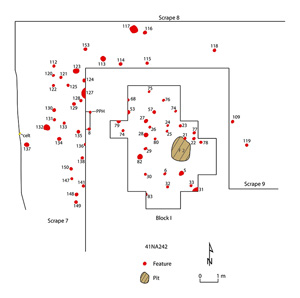
Pattern of postholes that represent re-building of structures at Beech Ridge. 
|
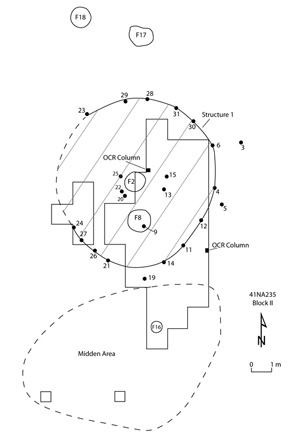
Structure 1 at Foggy Fork is is marked by an arc of 14 postholes representing a Caddo house some 8 meters across. 
|
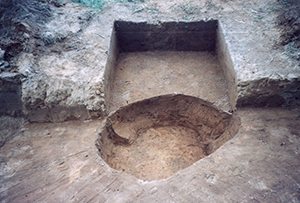
A storage pit located in a structure at Foggy Fork. 
|
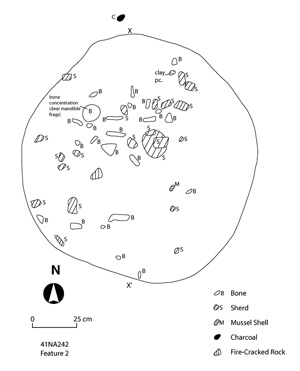
Feature 2, the largest pit found at Beech Ridge, could have been used to store over 19 bushels of maize. Like most storage pits, it was used as a trash pit after it was no longer serviceable for storage and filled with refuse, including animal bones and sherds. 
|
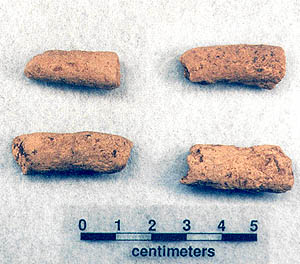
Caddo vessels were made by coiling strips of tempered clay together to form the vessel body and rim. The base was made from a single mass of clay shaped like a flat disk.  |
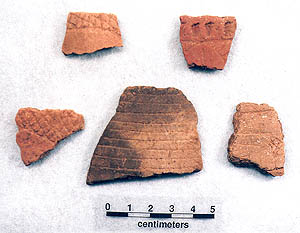
By the 16th century A.D., fine ware pottery makes up less than 2% of all vessel sherds found at the Naconiche Creek site.  |
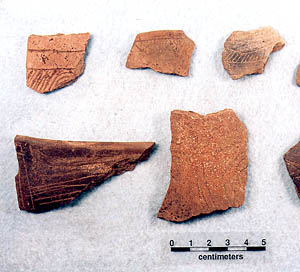
13th-15th century Caddo engraved wares, such as these sherds, were found at Naconiche Creek.  |
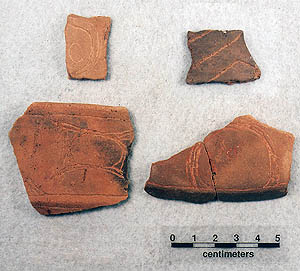
Fine ware vessels have a finely tempered paste, are usually burnished and carefully decorated with engraved designs, engraved designs with pigments, or a simple red slip.  |
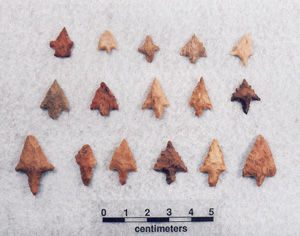
At the 15th century Foggy Fork site, almost half of the arrow points were made from petrified wood. Enlarge to see detailed descriptions.  |
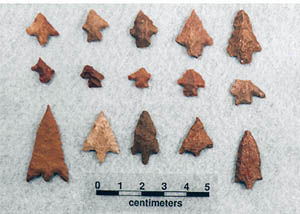
Caddo occupations in the Naconiche Creek valley are dominated by arrow points, outnumbering flake tools by almost three to one. Enlarge to see more examples of arrow points.  |
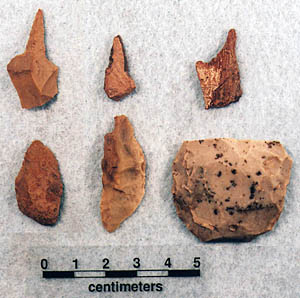
Caddo chipped stone tool kits frequently include expedient flake tools, scrapers, drills, and perforators.  |
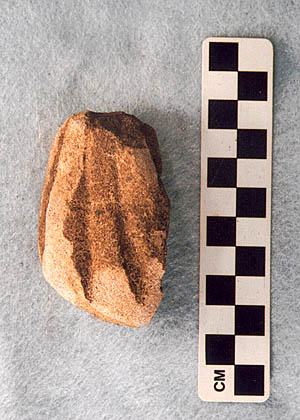
Ground stone tools such as this abrader, would have been used by the Naconiche for wood and bone shaft and tool straightening.  |
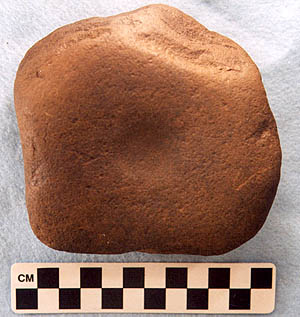
Pitted stones (above and below) are examples of tools the Caddo used in plant food preparation.  |
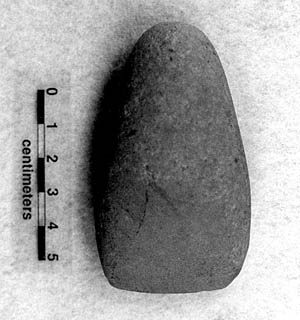
Celts found on Caddo sites are the best candidate for tree felling and woodworking tools.  |
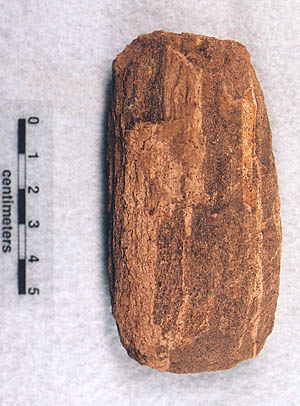
The Naconiche Caddo sometimes made their celts from locally obtained petrified wood.  |
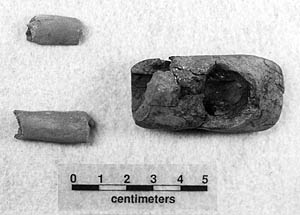
On the left, fragements of long-stemmed Red River style ceramic pipes found at Lake Naconiche. The pipe on the right is a very distinctive platform-type pipe found at Tallow Grove.  |
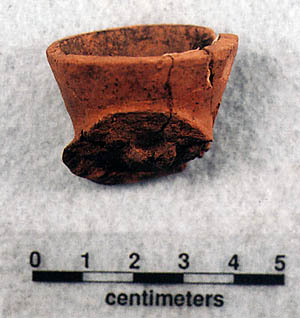
This rounded elbow pipe, found at Foggy Fork, was the only decorated pipe found.  |
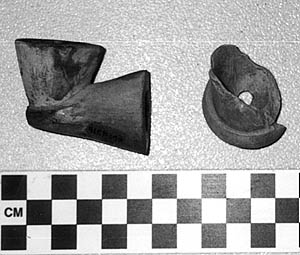
Sometime in the 14th century, the Caddo began to make L-shaped elbow pipes such as these, found at Lake Naconiche (right), and at a Smith County Caddo site (left).  |
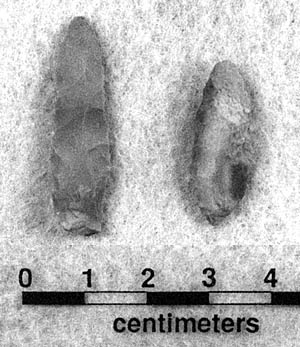
Found in a burial at Tallow Grove, these stone tools (drills) were placed by the left arm of an adult of unknown sex.  |
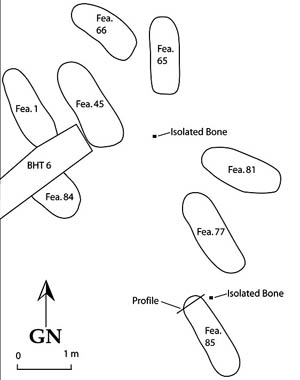
A Middle Caddo cemetery at the Tallow Grove site had eight graves, all those of adults. Most graves were oriented northwest-southeast, although Burial 81 was almost east-west. 
|
|

























